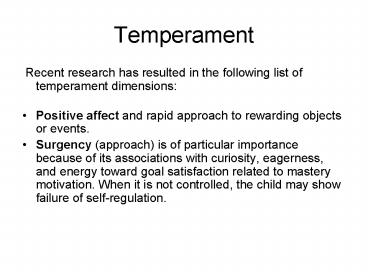Temperament - PowerPoint PPT Presentation
1 / 15
Title:
Temperament
Description:
Associative Sensitivity: Spontaneous cognitive content that is not related to ... cognitive skills, and. the accumulation of interpersonal experiences and ... – PowerPoint PPT presentation
Number of Views:308
Avg rating:3.0/5.0
Title: Temperament
1
Temperament
- Recent research has resulted in the following
list of temperament dimensions - Positive affect and rapid approach to rewarding
objects or events. - Surgency (approach) is of particular importance
because of its associations with curiosity,
eagerness, and energy toward goal satisfaction
related to mastery motivation. When it is not
controlled, the child may show failure of
self-regulation.
2
Temperament
- Fear - the tendency to negative affect and
inhibition or withdrawal in response to novelty,
challenge, or signals of punishment. - Fear reactions involve arousal, attention toward
the feared object, escape, and the arrest of
ongoing behavior. - Of particular concern - the influence of fear or
anxiety in disrupting thinking, for example, test
anxiety.
3
Temperament
- Irritability/Frustration - the affect associated
with responses to failure in goal attainment,
removal of reward, or blockage of progress. - Frustration has important implications in its
association with failure, aggression, and
defensive tendencies.
4
Temperament
- Attention / Effortful Control - Attentional
processes show considerable development with
maturation and are subject to habituation. - The executive attention system is responsible for
the deployment of attention for long-term goals,
planning and persistence. - The programming of effort control is considered
critical to socialization, particularly with
regard to development of attention, effort, and
conscience.
5
Rothbart Temperament
- EXTRAVERSION/SURGENCY
- Sociability Enjoyment derived from social
interaction and being in the presence of others.
- Positive Affect Latency, threshold, intensity,
duration, and frequency of experiencing pleasure. - High Intensity Pleasure Pleasure related to
situations involving high stimulus intensity,
rate, complexity, novelty, and incongruity.
6
Rothbart Temperament
- NEGATIVE AFFECT
- Fear Negative affect related to anticipation
of distress - Sadness Negative affect and lowered mood and
energy related to exposure to suffering,
disappointment, and object loss. - Discomfort Negative affect related to sensory
qualities of stimulation, including intensity,
rate or complexity of visual, auditory,
smell/taste, and tactile stimulation. - Frustration Negative affect related to
interruption of ongoing tasks or goal blocking.
7
Rothbart Temperament
- EFFORTFUL CONTROL
- Attentional Control Capacity to focus attention
as well as to shift attention when desired. - Inhibitory Control Capacity to suppress
inappropriate approach behavior. - Activation Control Capacity to perform an
action when there is a strong tendency to avoid
it.
8
Rothbart Temperament
- ORIENTING SENSITIVITY
- Neutral Perceptual Sensitivity Detection of
slight, low intensity stimuli from both within
the body and the external environment. - Affective Perceptual Sensitivity Spontaneous
emotionally valenced, conscious cognition
associated with low intensity stimuli. - Associative Sensitivity Spontaneous cognitive
content that is not related to standard
associations with the environment.
9
Rothbart Temperament
- Rothbart's Model of Temperament Reactivity and
Self-Regulation - According to this model , temperament is defined
in terms of individual differences in the
interaction of reactivity and self-regulation. - Reactions to the unfamiliar are conceptualized as
the behavioral manifestation of an individual's
attempt to modulate or regulate levels of
internal reactivity or arousal in response to
novel or unfamiliar stimuli.
10
Kagan Temperament
- Inhibited and Uninhibited "Types"
- Temperament is viewed as a set of qualitatively
different types which can be used to classify
people. Using this model, educators can identify
those children who exemplify the extremes (that
is, inhibited or uninhibited). Each extreme
describes 10 to 15 of children.
11
Behavior Temperament
- Successful management of temperament requires
that temperament traits be recognized for what
they are-normal variations of behavioral style
such as shyness or low adaptability. - Temperamental differences are best handled by the
improvement of the fit with the environment
primarily through environmental accommodations
rather than by attempts to modify the
temperament. - The presence of challenging temperament traits
does not necessarily lead to secondary behavioral
dysfunction if there are no complications and if
the traits are appropriately managed.
12
Coping Temperament
- Coping - an established pattern of handling life
situations - Factors contributing to coping
- developmental level,
- cognitive skills, and
- the accumulation of interpersonal experiences and
relationships - Temperament traits can become reinforced if they
are allowed to dominate coping strategies and
general approach to life situations as when
shyness is allowed to develop into a general
pattern of avoidance.
13
Sympathy Temperament
- Based on theory and research about sympathy and
personal distress, researchers draw the following
conclusions - Children who are prone to intense and frequent
negative emotions are low in sympathy. Thus,
interventions that help children manage their
negative emotions may be helpful in promoting
other-oriented sympathy. - Preschoolers and elementary school children who
are sympathetic tend to regulate their emotions
well. Thus, interventions that foster
children's emotional regulation are likely to
enhance their sympathy.
14
Sympathy Temperament
- Sympathy is an outcome of an optimal level of
vicarious emotional arousal. - For people prone to intense positive and negative
emotions, regulation is important for modulating
the effects of emotional reactivity. - For those who are not very emotional, regulation
of attention may enhance the likelihood of
attending to the needs of others. Thus,
interventions that enhance attentional or
behavioral control may foster sympathy.
15
Sympathy Temperament
- People who are sympathetic also appear to be
socially competent. - Sympathetic responding, socially competent
behavior, and low problem behavior are all
partially an outcome of the ability to manage
emotions in optimal ways. Thus, soft skills
training that emphasize understanding and control
of emotions may contribute to the development of
sympathy and empathy.































